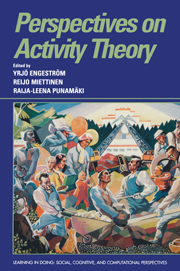Book contents
- Frontmatter
- Contents
- List of contributors
- Series foreword
- Introduction
- Part I Theoretical issues
- Part II Language and its acquisition
- Part III Play, learning, and instruction
- 14 Play and motivation
- 15 Drama games with 6-year-old children: Possibilities and limitations
- 16 Activity formation as an alternative strategy of instruction
- 17 Activity theory and history teaching
- 18 Didactic models and the problem of intertextuality and polyphony
- 19 Metaphor and learning activity
- 20 Transcending traditional school learning: Teachers' work and networks of learning
- Part IV Technology and work
- Part V Therapy and addiction
- Author index
- Subject index
17 - Activity theory and history teaching
Published online by Cambridge University Press: 05 June 2012
- Frontmatter
- Contents
- List of contributors
- Series foreword
- Introduction
- Part I Theoretical issues
- Part II Language and its acquisition
- Part III Play, learning, and instruction
- 14 Play and motivation
- 15 Drama games with 6-year-old children: Possibilities and limitations
- 16 Activity formation as an alternative strategy of instruction
- 17 Activity theory and history teaching
- 18 Didactic models and the problem of intertextuality and polyphony
- 19 Metaphor and learning activity
- 20 Transcending traditional school learning: Teachers' work and networks of learning
- Part IV Technology and work
- Part V Therapy and addiction
- Author index
- Subject index
Summary
Introduction
Why is teaching history part of elementary education, and how does it become useful for children outside the school context? How can concrete events and abstract principles be related in history teaching, and how can history be a means of relating to the past and orientating toward the future? How can the child become explorative and active in history teaching? These questions are central for history teaching and have been approached in different ways within various traditions of instructional theory.
In this chapter, I argue for an activity-theoretical approach to history teaching. The activity approach is characterized with the help of four principles. In the last part of the chapter, I use these dimensions to describe and analyze a history teaching experiment we conducted in Grades 4 and 5 in a Danish comprehensive school. In this experiment, historical knowledge was viewed as a tool for understanding the societies of today.
The objective of history teaching has changed over time (Engelund, 1988; Sødring Jensen, 1978; Manifest, 1983). In Denmark schools became public in 1814 and in Sweden in 1842 (Ramirez & Boli, 1987). From the beginning, history teaching in the Scandinavian countries had the task of developing students' national identity and moral character. This last task coincided with the ideals of the obligatory teaching of religion, and the two were the main objectives in public school teaching besides teaching reading (Sødring Jensen, 1978). The task of history teaching was transformed in the late 1950s.
- Type
- Chapter
- Information
- Perspectives on Activity Theory , pp. 282 - 297Publisher: Cambridge University PressPrint publication year: 1999
- 8
- Cited by



